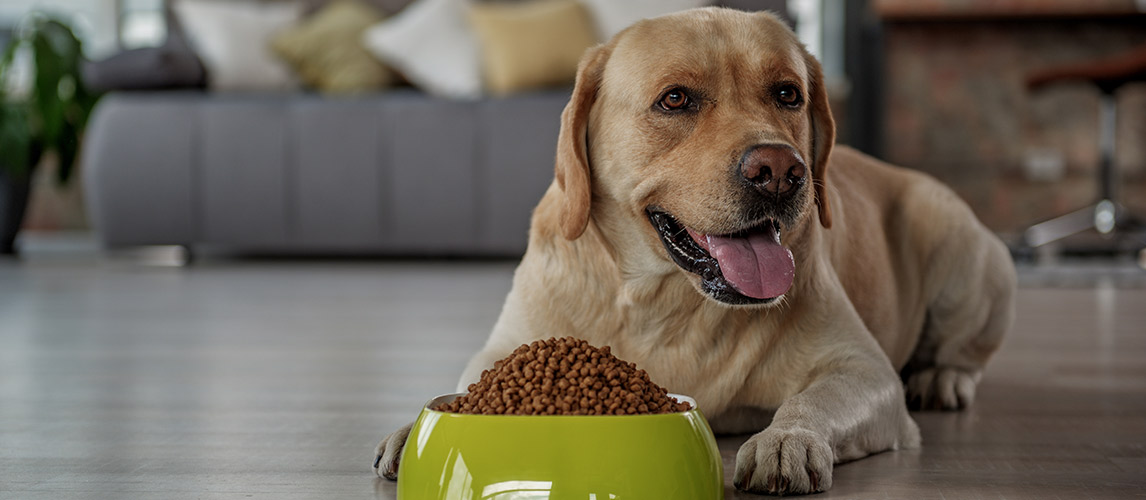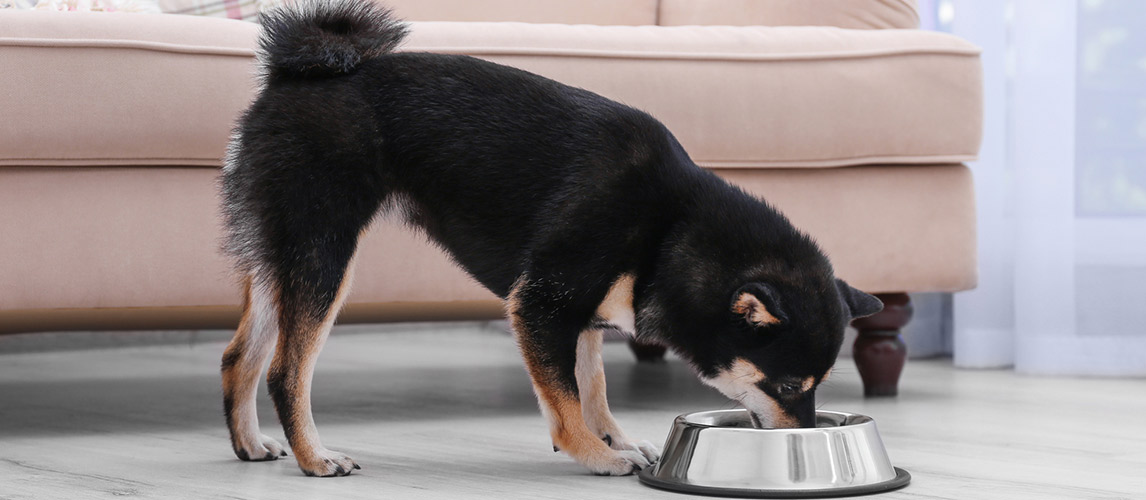Dog owners all want the best for their pups. As a society, we’re all used to products being easy to purchase. We inexplicitly trust household brand names without a second thought, having grown up watching their advertisements on our living room television screens. This post is going to look to explore the world of dog food and pet food labels. No more will you enter a store and pick up your regular brand without knowing exactly what is in the product and how healthy your dog’s diet actually is.
Dog Food Label Format
Pet food labeling can look really confusing if you haven’t researched much about it. There are some similarities with human food, namely the nutritional value table, but beyond that pet owners don’t usually know what they should be looking for.
Whether it’s dog food, tuna cat food, a store’s own brand of pet food, or a premium brand, all pet food can be read in the same way. That’s not to say that all pet food is created equal! Your dog and cat need different diets to stay healthy, so you should try your best to at least be aware of ingredients that could be harmful to your domestic animals.
Dog food labels (and yes, most other pet food product labels), will follow a similar format to this:
- Brand name
- Product name
- Weight of the product
- List of ingredients
- Nutritional analysis of the product (an analysis or breakdown of the nutrition in a serving of the dog food product)
- An adequacy statement about the research the brand does to ensure the quality of the product
- Feeding guidelines (amount of food for the weight of your pet, feeding directions)
- The company address of the manufacturer
In reality, most of this can be ignored by the average pet owner. What really matters in the world of meat-based pet foods is the percentage of some ingredients, the quality of the ingredients, and which ingredients are used.
Moisture content will appear on the label, as well. Moisture content is just the water content found in the analysis of the dog food. It can be beneficial for dogs that don’t drink enough water because they can get some of it from their everyday dog food.
The nutritional value, obviously, also plays a huge role! Overfeeding can easily cause your pet to gain weight, which can then cause health problems. It’s better to have feeding directions to follow than ignore feeding directions.
Common Ingredients in Dog Food
The ingredients section is, without a doubt, the most important part of any label on pet foods. Right next to the food nutrient profiles found in the nutrition chart.
Common ingredients that you’ll find in dog food are the following:
Protein
This could be meat, poultry, fish, or even plant-based protein products.
You may see the protein on pet food labels listed under corn gluten, soybean meal, beef protein, pork protein, and the like. All of these ingredients are fairly common, and it’s not unusual for several to be listed as animal protein on the same kind of meat meals dog food product.
Carbohydrates
While corn gluten and soybean meal are listed as protein in animal feed, other plant-based ingredients will make their way into the carbohydrate category.
This will include ingredients such as starches (sugar), and different fibers. You may see vegetable gums, beet pulp, or cellulose listed. These are all carbohydrate product ingredients.
Fats
Fat makes up an interesting percentage of a lot of dog food product blends. This is largely because fat is found in a lot of the common ingredients used in dog food, including meat, fish, plants and vegetables, poultry (like chicken fat), and more.
Omega-6 and Omega-3 are both sources of fatty acids used in dog foods and can be found in the ingredients list on the back of any decent dog food product. This is because Omega-6 is used for skin and coat maintenance, while Omega-3 has been shown to decrease inflammation and help with blood clotting.
Beyond Omega-6 and Omega-3, you may find other oil fats in the products that you use in your dog’s diet. These are animal fats from the animal products in the ingredients, and fat from the oil of other ingredients like fish and soya.
Vitamins and Minerals
The final major ingredient category for animal feeds is vitamins and minerals. These are a hugely important part of any animal food, and will ensure that the product has the adequacy to actually be part of the complete and balanced nutrition for your pet.
They’re also the reason that fat is needed in pet food products, whether the product is your local pet store brand or a brand that denotes itself as being a “premium” diet food. Without fat, Vitamin A, Vitamin D, Vitamin E, and Vitamin K cannot be absorbed into the body. Each of these does its own crucial part of keeping your dog healthy with their complete and balanced diet.
As well as these vitamins, Vitamin C and B-complex are included but need water to be absorbed. They are also vital parts of your dog’s health.
Minerals, on the other hand, provide skeletal support, assist with nerve transmissions, and aid muscle contractions. Without the range of vitamins and minerals included in dog food, your pup wouldn’t be as healthy as they are.
Ingredients to Avoid
This is not an exhaustive list, but here we offer a decent range of byproducts and ingredients that you should avoid feeding your dog. If you find any of these product names in the ingredients list of your pet food, we recommend putting it back on the shelf or having an informed conversation with your vet about them.
Melamine
A type of plastic added to dog food to make the food look meatier. It contains nitrogen and can be fatally toxic depending on the size of your dog.
Ethoxyquin, BHA, BHT
All of these are artificial preservatives used to extend the shelf life of a pet food product. The concerns about these preservatives are the potential of harm after long-term ingestion.
One study showed that Ethoxyquin, for example, raises hemoglobin pigment in the liver and elevates liver enzymes in the blood.
Propylene Glycol
Another artificial product, Propylene Glycol is used as an additive to maintain the texture of pet food. Though it’s recognized as a safe product by the FDA, it still isn’t recommended by experts because it’s an artificial ingredient.
Carrageenan
A thickener that is extracted from red seaweed, Carrageenan is safe to use! We’ve included it here despite this, to share awareness about its cousin, Poligeenan. Poligeenan is a degraded variation of Carrageenan, and studies have shown the potential harm it can cause.
Carrageenan is listed as safe to use by the FDA and AAFCO.
Meat Meal
This is a big one and it’s hard to escape it when looking at dog food products and dog food labels.
Meat meal is made up of scraps of unwanted parts of dead animals. It’s the leftovers that aren’t marketed to humans. Somehow, that makes it okay to cook them to remove the fat on the scraps, and then make a new product from theat. There’s protein in meat meal, sure, but who knows what animals that protein came from and what quality of meat is actually in the product.
It’s certainly an ingredient to avoid, no matter what the brand in question tells you about it. Why should your dog have subpar food?
Sodium Hexametaphosphate
Something that is marketed as being good for dental dog products, but isn’t actually healthy for your dog. When ingested, Sodium Hexametaphosphate can have adverse effects on your pup. If you want them to have cleaner teeth, choose a product without this ingredient on its pet food label.
MSG
This is used in all kinds of food – human and animal – as a flavor enhancer. It’s called a lot of silly names and often compared to salt that has been dialed up to eleven, but Monosodium Glutamate isn’t actually healthy.
It has zero nutritional valve, and it’s quite possible to be intolerant to it. If you find it listed as an ingredient in dog food, it’s likely that the manufacturer is trying to boost the flavor of a subpar product.
Food Dye
Not just food dyes, but corn syrup, too! There’s absolutely no need for your pet food product to have any dyes or syrup in. Dog food doesn’t need to look pretty and it certainly shouldn’t be sweetened. Dyed and/or sweetened food is trying to hide something: the quality of the food.
Finding Good Pet Food
Although we’ve listed a lot of bad ingredients, finding good pet food doesn’t need to be difficult. You can cut out a lot of the time you may have spent at the pet store by looking at each dog food ingredient list online.
Time-consuming, yes, but pet food manufacturers aren’t about to make it as easy as pie for you to find where they’re cutting corners. Just because that chicken flavor dog food looks good doesn’t mean it is. The adequacy statement provided by pet food manufacturers is required by law, but it’s the same kind of wordy blabble on every other adequacy statement.
Thankfully, by reading this article, you’ve made a good start. We’re sure that you’ve already pulled down a tin of dog food and stared at the ingredients while comparing them to the unhealthy and even toxic ones we’ve listed. That was the first step in finding good dog food for your furry friend.
Next comes more research. Quality dog food that doesn’t come with all the filler ingredients is hard to find. It’s also, usually, more expensive than other leading brands. That’s because healthy dog food isn’t mass-produced. Smaller companies will be putting a lot of care into the diet of your dog when you choose to feed your pup with their brand’s food.
Good Dog Food Brands
Before you start making your way through these short product overviews, let’s hop back to dog food labels for a second.
Like any other type of food, the first ingredient listed is the one that the product has the most of in it. The last is the least, and the rest fall into place between those two points.
So, if a dog food label has “chicken” listed first, that’s good. But if it has, let’s say, chicken meal listed first… Run. Find a better dog food brand. You know how to read a dog food label now, you’ll be able to quickly find something better.
Instinct – Raw Boost Mixers
Though this is technically a dog food topper, we needed to put this first on the list because this stunning dog food product doesn’t contain a single ounce of by-product meal from other animals. There’s also no grain, no artificial colors, and no preservatives.
Available as Lamb, Chicken, or Beef flavor dog food, these toppers are used to top off a bowl of dog kibble to give pups a bit more vitality than their standard kibble feed might give them. What dog doesn’t love a good bit of beef dog food?
ORIJEN – Original Biologically Appropriate Dog Food
We have to give kudos to ORIJEN here, they don’t hide anything that’s in their products. About halfway down the ingredients list, bold as anything, you’ll find both chicken and turkey cartilage listed, as well as ground chicken bone. We respect any company that has nothing to hide!
But, moving on to the good stuff: This dog food is absolutely packed with different meat, fish, eggs. Honestly, almost the entire ingredients list is a product that a human would eat, and that says a lot about this brand’s food. They promote fresh, raw animal ingredients in their food, as well as being high-protein and grain-free.
Taste of the Wild – Ancient Prairie
Available with ancient grains and as a grain-free version, Taste of the Wild offer dog foods that will take your dog back to their ancestor’s roots!
This amazing dog food is over 30% protein. It does contain chicken meal, but we couldn’t find any other ingredient from our avoid list in their food. The brand is all about putting real meat in their dog foods, as well as ensuring that the right vitamins and minerals are in there, too.
Freshpet – Home Cooked Chicken Recipe
This dog food is wonderful! It looks like something you could feed a human, which says good things about the brand. Freshpet have included cranberries and garden vegetables in this product, which you can clearly see among the strips of meat.
There are also no ingredients on the product ingredient list that appear on our list of things to avoid. Win-win!
The Grain-Free Argument
Dog foods that are produced without the use of grain products (wheat, rice, corn etc.) are considered “grain-free”. Grain-free has become a bit of a trend in recent years, with many brands labelling their products with the term.
Grain-free dog food uses alternative carbohydrates, typically from sources like potatoes and peas. There’s nothing wrong with any of these products; the reason behind grain-free dog food is a bit more myth-based.
The myth is that dogs are allergic to grains. This research-less accusation then opened up an entire market of grain-free product ranges for dogs. But it didn’t stop at one domestic pet, cats get the same treatment. You’ll find as many “chicken and rice” flavors on a shelf as grain-free ones, for both dog food and cat food.
The reality is that the grain allergy is present in less than one percent of all dogs. It’s a very uncommon allergy for a dog to have! Thankfully, if your dog is truly allergic to grains, at least there’s a market that caters to them now.
If you believe that your dog may be allergic or sensitive to their grain-based dog food, we highly recommend working with your vet to figure out if it is the food or if it’s something else. The first test is likely to be switching your dog to a grain-free diet and seeing what the results of that are.
Don’t be fooled by buzzwords from popular brands’ marketing departments.
The AAFCO and Dog Nutrition
Nutritional adequacy is required by law, but the line between what is healthy and what falls under nutritional adequacy is about as big as the length of a dog park. A big one. Nutritional adequacy does not equate to being healthy or delicious-tasting to your dog.
To find good dog food, owners start looking towards AAFCO for the answers.
Who are the AAFCO?
AAFCO is the acronym for the Association of American Feed Control Officials. This association charges itself with regulating the sale and distribution of animal food and medication for animals.
AAFCO Nutritional adequacy statement
The Association of American Feed Control Officials cannot approve or deny certain pet food products, that is beyond them. A pet food product need only meet the laws of the state to be sold, though many state laws do reference guides that were published by AAFCO.
To clear that up: AAFCO-approved dog food (or any pet food) does not exist, but the laws of the state do refer to AAFCO in the regulations for pet food. It’s not a very clear-cut situation, but the guides in question are certainly regarded as the bee’s knees.
The most relevant guide for this article would be the labelling guide. AAFCO has certainly influenced pet food labels. Under the regulations of Feed Control Officials (AAFCO), there must be a nutrition claim near any dog food ingredients. This “nutrition claim” is also called a “complete and balanced statement” or the “AAFCO statement of nutritional adequacy or purpose”; though we can all agree that last one is a little long.
Though a manufacturer may not be required to complete any tests using AAFCO procedures, or any animal feeding tests using AAFCO, themselves, they are still required to incorporate a statement on their product about the life stage of the animal that the product is suitable for.
This life stage statement must come on the back of the brand’s own research, which may have been from a laboratory analysis, feeding trials, or analysis comparable in nutritional adequacy.
That last method takes a finish product and another similar product that provides complete and balanced nutrition, and compares them by looking at the analysis of the two products.
The information on a dog food label must contain the above for AAFCO to be satisfied. AAFCO release a new official publication each year, and are well-regarded as experts in the world of dog foods. It’s their duty, in a way, to ensure that dog foods are being given more than a product name and a fancy dog food label.












I need a can dog food that has only 3 percent fat! Whst do you recommend!
I need can dog food with only 3 percent fat ! My pup has pancreatic and a heart mermor! Any sugestions?